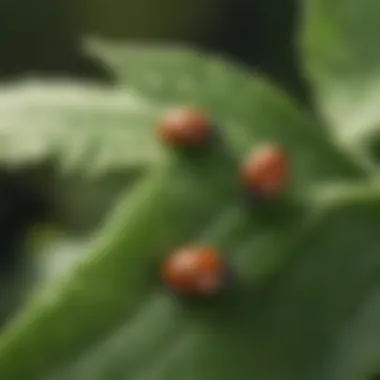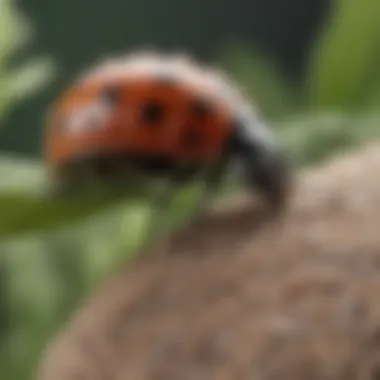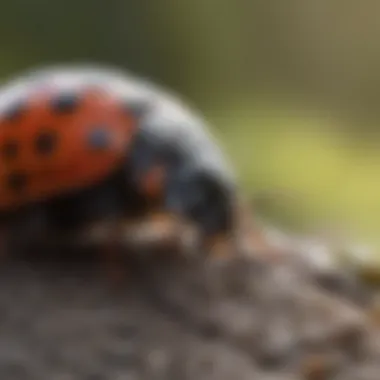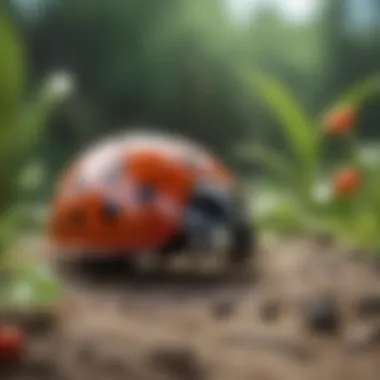Where to Buy Ladybug Larvae: A Comprehensive Guide


Nature Topic Overview
Ladybugs, also known as lady beetles, play a vital role in maintaining ecological balance. They are not just pretty little insects; they offer an invaluable service to our gardens. The larvae of ladybugs are particularly effective against harmful pests, including aphids. When we talk about buying ladybug larvae, we’re diving into a world where we can make a positive impact on our environment on both a personal and community level. Knowing how and where to acquire these small predators can help young learners, their parents, and teachers use a hands-on approach to understanding biology and ecology.
Fun Facts and Trivia
Did you know that there are over 5,000 species of ladybugs worldwide? Or that they come in a variety of colors, not just the classic red with black spots? Here are a few interesting tidbits:
- Aphid eaters: A single ladybug larva can consume up to 400 aphids in its lifetime.
- Colorful protection: Brightly colored ladybugs can deter predators because some are also toxic.
- Bellies of steel: They are known to store fat in their bodies, enabling their survival during winter.
These facts can spark curiosity in young minds, providing a springboard for classroom discussions or engaging home conversations.
Wildlife Explorations
In a natural garden environment, many different species share habitats with ladybugs. For example, the Green Lacewing and the Hoverfly also offer pest control benefits. Recognizing these species is beneficial for children as they learn about biodiversity. Each insect plays a role in the food web, teaching the interconnectedness crucial to ecosystem health.
Here’s a quick snapshot of related species:
- Green Lacewing: Often referred to as "aphid lions," these larvae feast on aphids and other small pests.
- Hoverfly: Resembling bees, hoverflies are efficient pollinators and their larvae consume aphids too.
Environmental Awareness
Understanding the importance of ladybug larvae helps cultivate a sense of stewardship among children.
"Insects like ladybugs teach us the necessity of balance in nature. Without them, certain pests would overrun crops, and our beautiful gardens would suffer!"
Here are several ways young learners can contribute to conservation:
- Create habitat gardens using native plants to attract ladybugs and other beneficial insects.
- Practice chemical-free gardening to avoid harming ladybugs and other insects.
- Participate in local conservation projects or activities aimed at preserving natural habitats.
DIY Nature Activities
Getting kids involved in nature can foster a lifelong passion for the environment. Here are some activities parents and teachers can try:
Ladybug Habitat in a Jar
Materials Needed:
- A clean glass jar
- Soil and small plants
- Ladybug larvae (after purchase!)
- Small stones
Instructions:
- Fill the jar about halfway with soil.
- Add small plants for the larvae to hide and feed on pests.
- Place a few small stones at the bottom for drainage.
- Once the setup is ready, add the ladybug larvae carefully.
- Observe and document how these little creatures help the plants thrive.
Nature Journal
Encourage kids to keep a journal of their ladybug observations, including drawings, notes, and findings.
Each of these engaging activities not only teaches ecological concepts but instills an appreciation for the natural world, turning theory into fun, applicable knowledge.
Prelims to Ladybug Larvae


Ladybug larvae are not just charming little critters; they play an integral role in the garden ecosystem. Understanding their significance can open up a world of knowledge. Parents, teachers, and young learners will find their importance, benefits, and how to nurture them very relevant.
The journey begins with recognizing what ladybug larvae are. These larvae are the young forms of ladybugs, often overlooked but crucial in controlling pests like aphids, which feast on plants. Just like how many heroes wear capes, ladybug larvae swoop in to save the day in gardens.
Understanding the Lifecycle of Ladybugs
Ladybugs do not appear as those delightful spotted insects right away. The lifecycle is fascinating and consists of several stages. First, you have the egg stage where a ladybug lays tiny yellow or orange eggs on the undersides of leaves, ensuring their new offspring have a steady supply of food nearby. Each egg hatches into a larva in about a week. This newly emerged larva looks quite different from its adult form and might not capture the attention of many.
These larvae will grow by molting several times, evolving through different sizes and forms before entering the pupal stage. Eventually, they complete their metamorphosis into adorable adult ladybugs. Knowledge of this lifecycle is crucial for anyone interested in gardening, especially aiding children in understanding growth and changes in nature.
Importance of Ladybug Larvae in Ecosystems
Ladybug larvae might be small, but their impact is mighty. As merciless predators of aphids, they help keep the balance in the food web of the garden. By consuming pests that can ruin plant life, they naturally control populations without the need for harmful chemicals.
When ladybug larvae are introduced into your garden, they not only help in pest management but also enrich the biodiversity of that space. A thriving ecosystem can lead to healthier plants and increased pollination thanks to its balanced environmental conditions.
"Ladybug larvae create a natural alliance in the ecosystem, assisting in the organic propagation of life."
Encouraging children and adults alike to familiarize themselves with these critters can transform how they perceive gardening and nature. Getting involved can mean learning responsibility, considering the environment, and celebrating the small wonders of life that can yield big results. In sum, understanding ladybug larvae is a stepping stone to fostering an appreciation for natural ecosystems.
Benefits of Ladybug Larvae in Gardening
When it comes to nurturing a flourishing garden, every little helper counts. Ladybug larvae are among those unsung heroes that can do wonders for your green space. Understanding the benefits of these tiny creatures is essential not just for gardeners but for kids, parents, and teachers who seek to immerse themselves in nature's cycles.
Ladybug larvae, the young stage of ladybugs, play crucial roles, and knowing what they can offer might make you eager to welcome them into your garden.
Natural Pest Control
Ladybug larvae are voracious eaters when it comes to pests, particularly aphids. Just imagine having a tiny but powerful pest control team at your disposal!
- Feeding Habits: A single larva can consume up to 400 aphids during its life stage. Think of them as a mini vacuum cleaner for your plants, sucking away those troublesome pests.
- No Chemicals Needed: By relying on ladybug larvae for pest control, you steer clear of harsh chemicals that can harm your plants and the surrounding environment.
- Sustainable Solution: Using natural predators like ladybugs helps maintain ecological balance. This method encourages a harmonious backyard ecosystem where both plants and insect allies thrive.
It's clear that the natural predatory behavior of ladybug larvae not only saves your garden from infestations but also nurtures a sustainable approach to gardening, one that could inspire young minds to appreciate the power of nature.
Enhancing Biodiversity
In today's world, biodiversity is vital for a healthy ecosystem. Gardeners who invite ladybug larvae into their spaces contribute positively to this diversity.
- Healthy Ecosystems: Ladybug larvae are a part of the intricate web of life. They not only help control pests but also provide food for birds and other wildlife, adding layers to the food chain.
- Educational Opportunities: For kids, observing ladybug larvae can be a fantastic educational experience. They offer a perfect opportunity to discuss life cycles, habitats, and the balance of ecosystems with engaging, real-life examples.
- Promotes Plant Health: A garden bustling with diverse life is generally healthier. Ladybug larvae support this by helping plants grow stronger and more resilient against pests and diseases.
"When we enable ladybug larvae to flourish in our gardens, we’re making a choice for ecological health and sustainability rather than relying solely on artificial solutions."
Inviting these little larvae not only transforms your space into an eco-friendly haven but also empowers children and adults alike to engage with nature in a meaningful way. Ladybug larvae represent the beautiful complexity of life, making gardens not just places for plants but thriving ecosystems.
Where to Purchase Ladybug Larvae
Finding the right place to buy ladybug larvae is more important than you might think. Not only does it ensure that you’re supporting local ecosystems, but it also gives you the opportunity to obtain healthy larvae for your garden. Various options exist for purchasing these beneficial insects, and each has its own set of benefits and considerations.
Local Garden Centers
Local garden centers often serve as the first stop for many gardeners eager to buy ladybug larvae.
Advantages of Local Purchases


Purchasing from local garden centers supports small businesses and helps foster community relationships. A key characteristic of buying locally is the ability to see and inspect the larvae before making a purchase. This offers a hands-on experience that online shopping cannot replicate. Additionally, local vendors may have knowledge about the specific ladybug species that thrive in your area, enabling you to make an informed decision. This connection to the environment and community can make your gardening experience more fulfilling.
Considerations When Buying Locally
While local purchases have their perks, several considerations come into play. The availability of ladybug larvae might vary based on the season or local demand, and there may be limited stock. Furthermore, prices might be slightly higher than online options due to overhead costs. Environmentally conscious buyers should also look into whether the center practices sustainable sourcing of insects, which can impact both quality and ecological balance.
Online Retailers
Online retailers have surged in popularity, making purchasing ladybug larvae easier than ever.
Evaluating Online Options
When selecting online retailers, it’s crucial to evaluate several factors, including customer reviews, shipping methods, and the seller's reputation. A standout characteristic of online shopping is the extensive variety of options available. Browsing through different websites means comparing prices, finding discounts, and even checking out other beneficial insects that can help your garden. While this convenience is appealing, buyers must assume the risk of larvae potentially arriving unhealthy due to transit issues.
Top Websites for Purchasing
Some reputable websites specialize in beneficial insects, including ladybug larvae. Notable mentions include Nature's Good Guys and Gardener's Supply Company, both recognized for their quality products and customer service. Buying from established brands often means well-packaged, healthy larvae. However, remember that shipping costs can add up, so always check if the total price fits your budget before clicking that “Buy Now” button.
Farmers Markets
Farmers markets present another unique venue for purchasing ladybug larvae.
Finding Local Vendors
At farmers markets, small-scale and local vendors often sell ladybug larvae alongside other organic products. The charm of these markets lies in their community vibe and the ability to speak directly with the vendor. A major advantage here is that you may find organically sourced larvae that are free from chemical treatments. This not only supports local farmers but also ensures you’re introducing healthy insects into the ecosystem of your garden.
Assessing Quality at Markets
Quality assessment is vital when buying from farmers markets. Inspect the larvae carefully – they should be lively and free from any signs of pests or disease. Speaking with vendors and asking about their sourcing practices can provide insights into the larvae's health. Some vendors may even offer guidance on the best practices for releasing the larvae into your garden. However, the inconsistency in stock might limit your options, so arriving early can be beneficial.
Buying ladybug larvae should be an experience woven with education and community interaction. Each option – be it a local garden center, online store, or farmers market – presents different avenues to learn and grow as a gardener.
Considerations When Buying Ladybug Larvae
Purchasing ladybug larvae is a task that beckons careful thought and consideration. While it's tempting to plunge into a purchase just because they’re cute or bring to mind the joys of nature, there’s more at stake here. Knowing how to choose healthy larvae and understanding the economics involved can dramatically influence your gardening experience.
One key aspect is the health and safety of the larvae. Are you getting a vibrant batch, or could some be sickly? Healthy larvae will thrive in your environment and effectively take care of pests that nip at your beloved plants. Without thorough examination, you may end up getting larvae that don’t survive or, worse, contribute to diseases in your garden. Besides, adopting ethical buying practices ensures that professionals follow guidelines respecting the larvae's habitat and lifecycle.
Another factor to ponder is quantity and pricing. You might find that buying a small quantity seems like a steal, but considering the size of your garden is vital. It might be more economical to buy in bulk to ensure they cover all areas. "Bite the bullet" and invest in enough larvae rather than skimping. Research the product types; sometimes, it’s worth a little extra to find organic or specifically bred ladybug larvae.
"Remember, the little creatures depend on us for a healthy introduction to their new home. Make every consideration count!"
Taking a step back to reflect on these considerations will not only nourish your plants but also deepen your understanding of the critical roles these tiny helpers play in the ecosystem.
After Purchase: Care and Release
Once you’ve decided to bring ladybug larvae into your garden, understanding how to care for them post-purchase is crucial. Caring for ladybug larvae is more than just keeping them alive; it’s about ensuring they thrive and fulfill their role in the ecosystem you've created. A gentle touch can go a long way in making your gardening experience successful and enjoyable.
Best Practices for Caring for Larvae
The first step in successful larvae care is to recognize their needs. These tiny creatures come with specific requirements that you should be mindful of:


- Temperature Control: Keep the larvae in a spot that’s warm but not too hot. Temperatures between 70°F to 85°F are ideal. Avoid leaving them in direct sunlight, which can quickly turn the habitat into a sauna.
- Moisture Levels: A little humidity can work wonders. Use a damp sponge or a paper towel in their container to maintain some moisture. However, be careful not to drown them; too much water is detrimental.
- Food Sources: Ladybug larvae are voracious eaters. Their diet should consist mainly of aphids, which are plentiful in gardens. If aphids are scarce, you can provide them with commercial food products designed for ladybugs.
- Space: It’s essential to give them enough space to grow. If you bought a large number of larvae, transferring them to a bigger container filled with breathable lid might be wise to give them room to move around freely.
"The healthier the larvae, the more effective they'll be at managing pest populations in your garden."
These practices ensure that you are taking steps toward maximizing the pests' effectiveness as natural predators. Taking time to understand the pre-adult stage can lead to many fruitful gardening adventures.
Ideal Release Conditions
Releasing ladybug larvae into your garden requires careful consideration of the environment you’re sending them into. Timing and conditions can make a significant difference in their survival and effectiveness:
- Optimal Time: Late afternoon or early evening is the best time to release them, as temperatures cool down and they can adapt to their new environment more easily.
- Weather Considerations: Avoid releasing them during heavy rain or when temperatures dip too low. Ideally, sunny days with slight cloud cover allow for a safer transition.
- Placement in the Garden: Release them close to plants that have aphid population. Ladybug larvae are instinctively driven to these food sources. Observing the garden beforehand can assist you in pinpointing which areas are thriving with pests.
- Safety Checks: Ensure no harsh chemicals have been recently sprayed in the area where you plan to release them. Pesticides pose a severe risk to ladybug larvae.
By caring for ladybug larvae properly and releasing them under the right conditions, you can expect to see a boost in your garden's health. This effort not only aids in maintaining a balance in nature but also teaches children a great deal about ecology and responsibility. With patience and knowledge, your ladybug larvae can become a cherished part of your gardening journey.
Monitoring the Impact of Ladybug Larvae
To truly reap the benefits of introducing ladybug larvae into your garden, it’s essential to monitor their impact. This process helps you understand how well these little predators are doing their job and ensures that your garden remains a healthy, balanced ecosystem.
Tracking Garden Health
The first step in monitoring is keeping an eye on the overall health of your garden. Ladybug larvae are well-known for their voracious appetite for aphids and other pest insects. By tracking the population of these pests, you can get a clearer picture of how effectively the ladybug larvae are working. Regular checks on the plants can help you note the changes in aphid numbers, and other problems can be spotted early on.
You might consider asking yourself:
- Are there fewer aphids on my plants?
- Are other pests disappearing?
- How do the plants look? Are they greener and healthier?
Taking notes can be a handy habit. It's like keeping a diary for your garden. This way, you can jot down any observations, and you might even start to see patterns about which plants are affected more than others.
Documenting Changes Over Time
Once you’ve tracked the immediate effects of ladybug larvae, the next step is to document those changes over time. This is akin to watching your favorite plant grow from a sapling into something magnificent. It’s rewarding to see the progress and understand the dynamic interactions in your garden.
Utilizing a simple record-keeping method can be beneficial. You could create:
- A garden calendar, marking key dates when you release the ladybug larvae and observe the pests.
- Photographs as visual documentation of your plants before and after introducing the larvae. This brings a powerful element to your observations, as nothing speaks louder than images.
- Charts or graphs that display pest populations over weeks or months can transform your observations into clear statistics. This allows you to see trends that may not be obvious at first glance.
Monitoring the health of your garden after adding ladybug larvae not only shows you how effective they are but also deepens your understanding of garden ecosystems.
By consistently tracking and documenting these changes, you're not just helping your plants thrive. You're also building an impressive knowledge base about the ecological balance in your garden. This understanding can inform future gardening decisions, ensuring a healthy environment for all your plants. It's a journey of discovery that can be both fun and enlightening!
Closure
In wrapping up this exploration into the procurement and use of ladybug larvae, it's vital to recognize the significant role these tiny helpers play in our gardens. This comprehensive guide has shed light on a variety of facets concerning where to buy ladybug larvae, from local garden centers to online retailers and the bustling atmosphere of farmers markets. Each purchasing avenue comes with its own set of advantages and considerations, making it essential for buyers to weigh their options carefully.
As parents, educators, and young learners delve into this journey, they discover not only the practical benefits of introducing ladybug larvae into their environments but also the larger ecosystem dynamics at play. Understanding how these larvae contribute to natural pest control can serve as a fascinating entry point into discussions about biodiversity and environmental stewardship. Here are some key points to reflect upon:
- Encouragement of Natural Balance: Deploying ladybug larvae helps maintain a healthy ecosystem by controlling aphid populations and other pests.
- Educational Opportunities: Engaging with ladybug larvae opens a door to learning about life cycles, habitats, and the interconnectedness of species in nature.
- Community Awareness: Supporting local vendors fosters a sense of community while ensuring that the larvae purchased are well-adapted to local environments.
Through careful consideration and responsible use of ladybug larvae, we contribute to a more harmonious gardening experience. The journey with these larvae not only enriches our green spaces but also brings clarity to the delicate threads that tie together all forms of life in our backyards. So, as this guide illustrates, buying ladybug larvae is more than just a gardening task; it’s about embracing nature’s patterns and fostering a love for the great outdoors.
Reflecting on the Journey with Ladybug Larvae
Taking a moment to reflect on the experience of acquiring ladybug larvae reveals much about life's little wonders. These small creatures are not just beneficial to gardens; they offer a grand adventure in understanding. The journey begins at the moment you decide to welcome these larvae into your space, each step filled with exploration and learning.
It's about watching that first batch of larvae develop, understanding their habits, and noticing how they influence the bug population in your garden. Here’s what one might consider:
- Learning Experience: Observing the transformation of larvae into ladybugs symbolizes growth and change, mirroring personal learning journeys.
- Engagement with Nature: Being involved in this process often sparks curiosity among children, leading them to ask questions about other insects, plants, and ecosystem functions.
In essence, the conclusion of our search does not stop with purchasing. It extends into nurturing an ongoing relationship with ladybug larvae as they grow and contribute to our gardens. It's a cycle that not only benefits our plants but also cultivates a deeper appreciation for the natural world around us.







